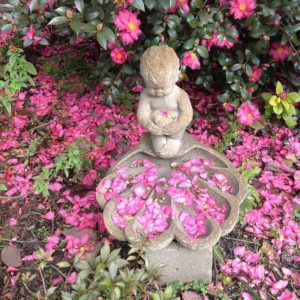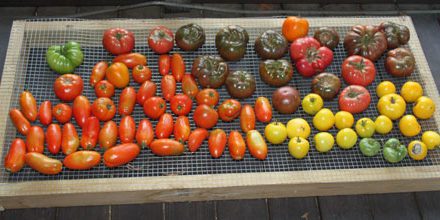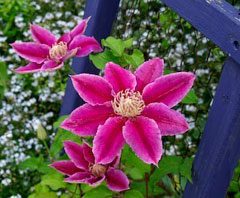
Fallen camellia blossoms in Sandra’s backyard
Spring: My move down here from the north was in the spring, and the first thing I noticed was that someone had thrown buckets of yellow paint all over my bare front yard. “Some welcome!” I thought. “What kind of Southern Hospitality is this??”
Well, you’ve probably guessed. It wasn’t paint. It was pine pollen. That annoying, gritty, cough and itchy-eyes producing pollen. This was a particularly bad year (or good, if you’re a pine tree) for pollen. In spring, not only a young man’s fancy turns to thoughts of love; so do pine trees and they spread their ‘love’ everywhere!
For two or three weeks every spring, the Lowcountry turns yellow. There are no clandestine meetings, because your footprints in the pollen will give you away. Your hand turns yellow when you open your car door, and the car runs out of washer fluid within days. The glory of spring flowering redbuds and Loropetalum is dimmed by a blur of yellow. Wind won’t blow it away; you have to wait for rain. My entire property is bordered by stands of pines so that even my koi pond was covered with yellow. The koi are the only ones who didn’t seem to mind.
Spring is the time to pull away the black and ugly winter damaged leaves and cut back dead stalks and branches. Rake away any leaves and garden detritus resting against the trunks and stems of trees and shrubs. As beautiful as they are, the fallen blossoms of Camellias can harbor pathogens so they should be raked and removed.
This photo is a classic case of “Do as I say . . . not as I do.” The fallen blossoms were just too pretty to rake away. So I left them. Wouldn’t you?
Early spring is also the time when we need to prepare our defenses against weeds. If you’re so inclined, there are pre-emergent herbicides such as Preen or Snapshot which should have already been applied in February. But it’s not too late to be effective for the weeds that haven’t germinated yet. Mulch is another weapon in your arsenal. Purchased mulch can be expensive, so you might be inclined to be skimpy with it. Don’t be. Too little mulch is a total waste of money. Apply a good 3 or 4 inches of any bark mulch, and even more if you use pine straw. Leave a mulch free circle around the base of trees and shrubs.
Summer: Summer down here is pretty much limited to iced tea and afternoon naps. Folks like me who don’t have vacation homes in the north just sigh and count the days until fall. Even our gardens seem to become lazy and languid, saving their energy until the cool weather spurs a burst of new growth. By August, almost everything has stopped flowering, so I’ve learned to make Ikebana type ‘arrangements’ with just a blossom or two and spray painted twigs and branches.
Seems like everything we do in summer is in slow-motion.
But gardeners are intrepid, some even say foolhardy, and we brave all kinds of peril so that we can do what we love best: work and play in the garden. On a Rent-a-Master Gardener visit a couple of years ago, I was greeted by the homeowner wearing a complete bee-keepers outfit. I inquired about her bees and was told this wasn’t for bees, it was for no-see-ums! “It’s the only way I can garden.” she said. “I’m allergic to them.” I’m bothered by them too, and I looked at the active ingredients in one of those after bite anti-itch pens. It was common household ammonia. I used just the ammonia and it worked! $4.95 for the pen vs. 79 cents for a quart of ammonia. Who knew?
Autumn: The second best season in the Lowcountry (what can surpass spring?) is autumn. Summer-weary flowering plants are invigorated, and so is the gardener. It’s also the best time to plant shrubs and trees. The cool fall and winter weather gives the roots time to settle in before top growth begins.
Although we can’t begin to rival the autumn color changes of the north, some of our trees and shrubs do give us a lovely display. Bald Cypress, Crape Myrtle, ornamental grasses and yes, that awful Virginia Creeper vine, take center stage. We also have the profuse yellow berries of Duranta, and the bright red berries of Holly, Nandina and Ardesia against their evergreen foliage.
Fall also is the beginning of the end for heat loving biting critters. The numbers of mosquitoes and no-see-ums begin diminishing and it’s actually possible to stroll around the garden of an evening. The gingers are wafting their delicious fragrance through the garden and you remember why you settled here. The quintessential southern plants, Camellias, provide reliable and gorgeous colorful blossoms starting in fall, and lasting through mid-spring!
And I found from a fellow Master Gardener, Wendy Hilty, that if I plant seeds in mid-October of those longed-for flowers “that just don’t grow here,” like Sweet-Peas and Delphiniums, they will sail through our winters and bloom in spring. Life is good.
Winter: If you’re like me, your winter bedtime reading is looking through seed and plant catalogs. And drooling. I look at the beautiful photos of lilacs, peonies, tulips and such and lament that our heat and humidity preclude growing them successfully down here. But then I perk up when I realize that we can grow as perennials many of the plants that are annuals only a Zone away. Like Gerber Daisies, Agapanthus, Dahlias and even Impatiens . . . some years. We’re also blessed with a growing season that allows us to grow two vegetable crops a year. And enjoy semi tropicals like citrus and bananas.
Winter is also the time to celebrate our favorite holidays and wistfully think of snow. Somehow though, sleigh bells just don’t jingle in the Lowcountry.
So gardening is like life; a series of trade-offs and compromises. I have never met a real gardener who is a pessimist. The DNA of a gardener is eternally optimistic. Those two temperaments can’t coexist in the same body. If it didn’t work today, there’s always tomorrow. Like Annie, we love tomorrows. They’re only a day away . . .
Gardening Tip: Put a kitchen timer in your pocket when you go outside to garden on hot days. Gardeners lose track of time, and 30 minutes at a time in the heat is enough. Go in and have a glass of water and something salty.









